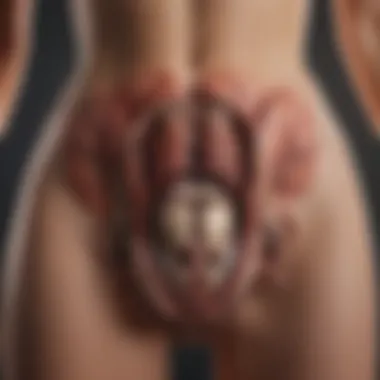Healing the Pelvic Floor After Birth: A Comprehensive Guide


Intro
The journey of motherhood is transformative, yet it often brings challenges that remain unspoken. One significant concern for many new mothers is the health of the pelvic floor after childbirth. This area plays a critical role in various bodily functions, and its health can greatly influence a mother’s overall well-being. Understanding the pelvic floor's anatomy and its changes during and after pregnancy is essential for effective recovery.
The pelvic floor comprises a group of muscles and connective tissues that support the bladder, uterus, and bowels. During childbirth, these structures undergo considerable strain, leading to potential dysfunction or discomfort. Postpartum recovery, therefore, becomes vital, encompassing physical, emotional, and social dimensions.
It is crucial to approach pelvic floor healing holistically. This guide aims to explore the anatomy, postoperative implications, and practical recovery strategies that new mothers can implement. Our intent is to offer evidence-based insights and support for mothers navigating this critical aspect of their healing journey.
"Preventive care and early intervention are key to minimizing long-term pelvic floor issues."
By discussing anatomy, recovery exercises, nutritional guidance, and self-care practices, we can foster a better understanding of how to rehabilitate the pelvic floor effectively.
Understanding the Pelvic Floor
Understanding the pelvic floor is fundamental to recognizing the challenges many women face after giving birth. The pelvic floor comprises a complex network of muscles, ligaments, and connective tissues which support various organs, including the bladder, uterus, and rectum. After childbirth, this area can undergo significant changes that can affect both physical health and emotional well-being. Being informed about the pelvic floor is crucial for effective recovery and long-term health.
Anatomy of the Pelvic Floor
The anatomy of the pelvic floor is intricate. It includes the pelvic diaphragm, which consists of the levator ani and coccygeus muscles. These muscles form a supportive structure that holds the pelvic organs in place. Additionally, the pelvic floor contains ligaments and connective tissues that contribute to its stability.
Changes in this area can lead to conditions like prolapse, where the organs shift from their normal position. Knowing the specific anatomy helps in understanding how each part functions and interacts with others. This insight is essential when seeking treatment or engaging in recovery activities.
Function of the Pelvic Floor
The pelvic floor serves several critical functions. Primarily, it provides support for the pelvic organs and contributes to urinary and fecal continence. These functions are vital for maintaining daily activities and overall quality of life. When the pelvic floor is weak or damaged, which can occur during childbirth, individuals may experience challenges like incontinence and pelvic pain.
Moreover, the pelvic floor plays a role in sexual function. Proper strength and coordination in this area contribute to sexual health and satisfaction. Understanding the functions of the pelvic floor empowers individuals to take proactive steps in recovery. Exercises specifically designed for strengthening this area, along with informed medical guidance, can promote healing after childbirth.
"A well-functioning pelvic floor is integral to numerous bodily functions including core stability, continence, and pelvic organ support."
Recognizing the anatomy and function of the pelvic floor provides the foundation for a comprehensive understanding of recovery after childbirth. This knowledge prepares women to engage with their healthcare providers effectively.
Effects of Childbirth on the Pelvic Floor
Understanding the effects of childbirth on the pelvic floor is crucial for new mothers. The pelvic floor sustains a significant transformation during and after the birthing process. This section delves deeper into how labor and delivery impact this vital area, highlighting physical changes and potential disorders post-birth. Recognizing these effects is the first step towards effective recovery and maintaining pelvic health in the long-term.
Physical Changes During Delivery
The journey of childbirth brings about substantial physical alterations to the pelvic floor. During delivery, the pelvic muscles and ligaments stretch significantly. This stretching aids the passage of the baby. However, excessive strain can lead to trauma. A few key changes occur:
- Muscle Stretching: The pelvic muscles may stretch beyond their normal ranges. This does not mean they will automatically return to their pre-pregnancy state after birth.
- Nerve Injuries: Some women may experience nerve damage during delivery, leading to reduced sensation or weakness in pelvic muscle function.
- Supportive Structures: The connective tissues that support organs like the bladder and uterus can become weakened, causing issues later on.
These transformations underline the importance of awareness among new mothers. Healing practices that address these changes can mitigate long-term complications.
Common Pelvic Floor Disorders
Following childbirth, various disorders can emerge, primarily related to compromised pelvic floor function. Understanding these vulnerabilities allows for proactive care. Some common disorders include:
- Urinary Incontinence: This is a prevalent issue where women may involuntarily leak urine due to weakened pelvic floor muscles.
- Pelvic Organ Prolapse: When pelvic muscles are weakened significantly, it can lead to conditions where organs like the bladder, uterus, or rectum protrude into the vaginal canal.
- Fecal Incontinence: This condition involves a loss of control over bowel movements, caused by nerve and muscle damage sustained during childbirth.
Addressing these disorders swiftly can prevent further complications and improve the quality of life.
In summary, the effects of childbirth on the pelvic floor are multifaceted. Awareness of these effects is vital for effective recovery. Immediate attention to any discomfort and open communication with healthcare providers can foster a supportive recovery journey for new mothers.
The Importance of Postpartum Care
Postpartum care plays a crucial role in the recovery journey after childbirth. During this period, the body undergoes significant changes, and attention to pelvic health is essential. Failing to address these changes can lead to long-term complications, including pelvic floor disorders. Thus, understanding the importance of postpartum care becomes pivotal for new mothers.


The postpartum period is not merely about physical recovery; it encompasses emotional and psychological well-being as well. It is a time when the body is healing from labor while adapting to the demands of motherhood. Investing in postpartum care helps in creating a strong foundation for future health. It lays the groundwork for maintaining pelvic floor integrity and function.
Benefits of Early Intervention
Early intervention in postpartum care can drastically improve recovery outcomes. When a woman seeks help soon after birth, she can address issues before they escalate. These issues may include incontinence, pelvic organ prolapse, and pelvic pain. Identifying them early can lead to effective treatment options that might otherwise become more complex with time.
Furthermore, early intervention promotes mental health. Engaging with healthcare professionals can provide reassurance, guidance, and a sense of community. This support network can help relieve anxiety and stress that often accompany new motherhood.
Key benefits of early intervention include:
- Identification of Concerns: Healthcare providers can thoroughly assess pelvic health, pinpointing any issues.
- Tailored Treatment Plans: Early detection allows for personalized recovery strategies based on individual needs.
- Preventative Measures: Addressing issues early reduces the risk of chronic conditions in later life.
- Mental Health Support: Access to counseling and support groups can improve emotional well-being.
Frequency of Postpartum Check-ups
Regular postpartum check-ups are vital in maintaining pelvic floor health. These visits allow healthcare providers to monitor recovery progress and address any emerging concerns. Depending on individual circumstances, the frequency of these check-ups can vary.
Common practice suggests that new mothers should schedule visits at:
- 6 weeks postpartum: This is typically the first routine check-up. Providers assess healing, discuss birth experiences, and evaluate any pelvic symptoms.
- 3-6 months postpartum: Depending on symptoms and initial assessment, a second visit may be advised to ensure continued healing.
- Ongoing assessments: For mothers experiencing complications, ongoing appointments may be necessary to manage their health.
It's also essential for women to communicate their needs during these visits. Many may feel hesitant to discuss pelvic issues due to embarrassment. However, it is critical to remember that healthcare professionals are well-equipped to handle such matters sensitively and professionally.
Each visit to the healthcare provider should serve as an opportunity for dialogue and education. Expressing concerns openly leads to better health outcomes and strengthens the therapeutic relationship.
Ultimately, prioritizing postpartum care with timely interventions and regular check-ups can immensely benefit new mothers. It allows them to recover effectively and ensures the long-term health of the pelvic floor.
Exercises for Pelvic Floor Recovery
Exercises that focus on recovering the pelvic floor are crucial after childbirth. They help restore the strength and function necessary for daily activities. Many new mothers experience changes that can lead to discomfort, incontinence, or pelvic pain. Engaging in a structured exercise regimen helps mitigate these effects.
The benefits of pelvic floor exercises include improving bladder control, enhancing sexual function, and fostering overall core stability. Additionally, these exercises support mental health by empowering women during the recovery process. Knowing they can actively participate in their healing can lead to a greater sense of wellbeing.
Consistency is significant in performing these exercises. It is vital to incorporate them into daily life. Moreover, new mothers should listen to their bodies and adjust the intensity of the exercises to fit their comfort levels.
"Incorporating pelvic floor exercises can lead to a significant improvement in recovery and overall pelvic health."
Kegel Exercises
Kegel exercises are at the forefront of pelvic floor recovery strategies. They specifically target the muscles that support the urethra, bladder, uterus, and rectum. To perform Kegel exercises correctly, one must first identify the pelvic muscles. A good way to do this is by contracting the muscles used to stop urination. Once identified, these muscles can be engaged even when not urinating.
Steps to perform Kegel exercises include:
- Find a comfortable position: This can be lying down, sitting, or standing.
- Contract the pelvic muscles: Hold for five seconds.
- Relax for five seconds: Repeat this cycle up to ten times.
- Aim for three sets a day: Gradually increase holding time as strength improves.
Kegel exercises can be discreetly done anywhere, making them an ideal choice for new mothers managing busy schedules.
Core Strengthening Activities
Strengthening the core is equally crucial in pelvic floor recovery. Weak core muscles can exacerbate pelvic floor dysfunction. Activities that enhance core stability will increase support for the pelvis, thus improving overall body mechanics.
Some effective core strengthening exercises include:
- Pelvic Tilts: Lying on your back with knees bent, gently arch and flatten your lower back.
- Bridges: Lying on your back, lift your hips while keeping your shoulders on the ground.
- Dead Bugs: Lie on your back and alternate lowering arms and legs while stabilizing the core.
Incorporating these exercises helps build a strong foundation for pelvic floor health, reducing pressure on pelvic structures.
Breathing Techniques
Breathing techniques are often overlooked but serve an essential role in pelvic floor recovery. Proper diaphragmatic breathing encourages relaxation and improves oxygen supply to the pelvic area. It also helps engage the pelvic floor muscles more effectively when performing other exercises.


To practice diaphragmatic breathing:
- Lie on your back with knees bent.
- Place one hand on your chest and the other on your belly.
- Inhale deeply, allowing your belly to rise while keeping your chest still.
- Exhale slowly and feel your belly fall.
Practicing this technique regularly can greatly enhance relaxation and focus, promoting better overall recovery.
In summary, incorporating specific exercises for pelvic floor recovery is vital for new mothers. Kegel exercises, core strengthening activities, and breathing techniques collectively contribute to a more supportive and functional pelvic area. Engaging in these practices ensures a more comprehensive recovery post-birth.
Nutrition and Its Role in Recovery
Nutrition plays a pivotal role in the healing process after childbirth. A well-balanced diet supports recovery, promoting overall health and well-being. Focusing on the right foods can significantly impact the strength of the pelvic floor. New mothers often overlook their nutritional needs during this critical recovery period, prioritizing their baby's needs instead. However, the rejuvenation of pelvic health is directly related to what mothers consume.
It is vital to understand that nutrition is not just about eating; it includes timing and balance of nutrients. Adequate hydration, for instance, enhances cellular functions and nutrient transportation. Mother should consider their daily intake carefully to ensure they are meeting their body's increased needs after childbirth.
Hydration and Its Importance
Proper hydration is fundamental for healing. Water is essential for maintaining bodily fluids, regulating temperature, and supporting metabolic processes. During recovery, the body requires more fluid to flush out toxins and reduce inflammation. New mothers may experience dehydration, especially if they are breastfeeding. Not retaining enough fluid can interfere with healing and might complicate recovery.
Some benefits of adequate hydration include:
- Enhanced circulation: Promotes nutrient delivery to healing tissues.
- Improved digestion: Prevents constipation, which is crucial post-delivery.
- Reduced fatigue: Alleviates tiredness that often accompanies new motherhood.
Mothers should aim to drink at least eight to ten cups of fluids daily, focusing on water, herbal teas, and broths. Foods with high water content, like fruits and vegetables, also contribute to overall hydration.
Essential Nutrients for Healing
The healing process necessitates specific nutrients that are often lacking in an average diet. These important nutrients support tissue repair, reduce inflammation, and restore energy. New mothers should focus on incorporating these elements:
- Protein: Crucial for tissue repair and muscle recovery. Foods such as chicken, fish, eggs, legumes, and nuts are excellent sources.
- Omega-3 Fatty Acids: Help reduce inflammation and can be found in fatty fish like salmon, walnuts, and flaxseeds.
- Vitamin C: Supports immune function and collagen synthesis. Sources include citrus fruits, strawberries, and bell peppers.
- Iron: Vital for replenishing lost blood, especially post-delivery. Foods rich in iron include spinach, red meat, and lentils.
- Calcium and Vitamin D: Important for bone health, especially during breastfeeding. Dairy products, leafy greens, and fortified cereals provide these nutrients.
Physical Therapy for Pelvic Health
Physical therapy plays a crucial role in the recovery of the pelvic floor after childbirth. Many women experience various degrees of pelvic discomfort, weakness, or dysfunction post-delivery. Engaging with specialized pelvic floor physical therapy can provide targeted support and rehabilitation. The benefits of this therapy extend beyond immediate relief; they also assist in restoring overall pelvic health, enhance quality of life, and prevent future complications related to childbirth.
A customized physical therapy program focuses on individual needs. These programs often include a combination of education, exercises, and manual therapy techniques tailored to address specific issues a mother may face. The guided nature of this therapy ensures that exercises are performed correctly and safely, reducing the risk of injury.
Moreover, pelvic floor physical therapy is not just beneficial for women who experience noticeable issues. It can serve as a preventive measure, helping to educate new mothers on maintaining pelvic health well after the birth process.
"Consulting a specialist sooner rather than later can significantly improve recovery outcomes and promote long-term pelvic health."
When to Consult a Specialist
Recognizing when to seek help from a pelvic floor specialist is vital. While some discomforts may resolve on their own, persistent symptoms should not be ignored. Signs that indicate a need for professional intervention include:
- Chronic pain in the pelvic region.
- Incontinence during activities or at rest.
- Pain during intercourse or discomfort that affects intimacy.
- Difficulty with bowel movements or urination.
- Unusual pressure or heaviness in the pelvis.
If any of these symptoms appear, it is prudent to consult a pelvic floor physical therapist. Early intervention can help mitigate long-term complications.
Methods Used in Pelvic Floor Physical Therapy
Pelvic floor physical therapy employs a variety of methods to facilitate healing. Understanding these techniques allows patients to be more informed about their treatment options. Common methods include:
- Pelvic floor exercises, which enhance strength and flexibility.
- Biofeedback, a method that uses sensors to provide information about pelvic floor muscle contractions, helping individuals learn how to engage these muscles effectively.
- Manual therapy, which involves hands-on techniques to relieve tension, improve blood flow, and enhance mobility.
- Education on posture and body mechanics to promote proper alignment during daily activities.
- Breathing techniques designed to regulate the pelvic floor and alleviate tension.
These approaches can be blended into a comprehensive treatment plan tailored to the individual, ensuring effective and holistic care.
Self-Care Practices
Self-care practices play a crucial role in the recovery of the pelvic floor after childbirth. This period can be challenging both physically and emotionally. Engaging in self-care activities not only aids physical healing but also promotes mental well-being for new mothers. Understanding the importance of self-care is essential to navigating postpartum recovery effectively. It encompasses a range of strategies designed to support overall health, address specific needs of the pelvic floor, and foster a positive mindset.


By prioritizing self-care, new mothers can cultivate resilience and enhance their recovery experience. Some key benefits of self-care practices include:
- Improved Mental Health: Caring for oneself can reduce feelings of anxiety and depression which often accompany the postpartum period.
- Enhanced Physical Recovery: Activities designed for relaxation and mindfulness can alleviate tension, contributing to physical recovery.
- Empowerment: Taking charge of one's own health through thoughtful self-care can foster a sense of control amid the many changes that occur after giving birth.
Mindfulness and Relaxation Techniques
Mindfulness and relaxation techniques are valuable components of self-care practices for postpartum recovery. These techniques encourage new mothers to remain present and manage stress effectively. Practicing mindfulness helps in recognizing and accepting thoughts and feelings without judgement. This approach leads to a better understanding of one's emotional state, which is particularly beneficial in the often overwhelming postpartum period.
Relaxation techniques can include practices such as:
- Meditation: Regular meditation sessions can calm the mind and create mental space for emotional regulation.
- Deep Breathing: Techniques like diaphragmatic breathing help reduce stress and promote relaxation. Even short sessions can significantly impact recovery.
- Gentle Yoga: Engaging in gentle stretches can alleviate physical tension while also serving as a mindfulness practice. Yoga routines tailored for postpartum recovery can help restore balance.
Incorporating these techniques into daily routines creates pathways to manage stress and promote a sense of peace. Engaging with these practices can lead to greater body awareness and contribute positively to pelvic floor recovery.
Managing Stress During Recovery
Managing stress during recovery is pivotal for both mental and physical health. The postpartum phase often involves numerous stressors, including sleep deprivation and the pressures of caring for a newborn. Understanding how to manage stress actively can have profound effects on the recovery process.
There are several effective strategies that can assist in stress management:
- Setting Realistic Goals: Accepting that some days may be more challenging than others allows for flexibility in recovery.
- Social Support: Engaging friends and family can provide emotional support. Sharing experiences and challenges can foster a sense of community.
- Prioritizing Rest: Quality sleep is essential. New mothers should aim to rest whenever possible, including taking naps while the baby sleeps.
- Establishing a Routine: A gentle daily routine can offer structure and predictability, which helps in managing postpartum life.
- Self-Compassion: It is crucial to be kind to oneself. Healing takes time and acknowledging progress, however small, is vital.
Managing stress is not just about eliminating stressors; it is about finding effective ways to cope and nurturing a sense of balance in daily life.
By incorporating mindfulness, relaxation techniques, and proactive stress management, new mothers can support their journey towards healing the pelvic floor. This holistic approach ensures that both body and mind are nurtured during the recovery process.
Long-Term Pelvic Floor Health
Understanding long-term pelvic floor health is essential for women who have given birth. After childbirth, the pelvic floor undergoes significant changes. These changes affect not only physical well-being but also emotional and social aspects of life. A robust pelvic floor promotes stability and function in daily activities. Therefore, prioritizing long-term care is vital for maintaining overall health.
Maintaining Strength and Function
To ensure strength and function of the pelvic floor, regular exercise and awareness of body mechanics are crucial. Strengthening the pelvic floor muscles helps prevent issues such as urinary incontinence, pelvic pain, and prolapse. Here are methods to maintain pelvic floor strength:
- Kegel exercises: These are the most commonly recommended. Performing them correctly can enhance muscle tone and strength.
- Core stability: Engaging core muscles through targeted exercises can provide support for the pelvic floor. Activities like Pilates and specific yoga postures are beneficial.
- Posture awareness: Proper posture during daily activities reduces unnecessary strain on pelvic muscles. Keeping the pelvis neutral while sitting or standing has positive effects.
Regularly practicing these techniques can foster a stronger pelvic floor. Monitoring progress through journaling exercises or consulting with professionals may also provide motivation and improvement.
Identifying Future Concerns
Remaining vigilant for future concerns is an integral part of long-term pelvic health. Several signs might indicate issues requiring attention. Some common concerns include:
- Increased urinary urgency or leakage during physical activities.
- Chronic pelvic pain that persists post-recovery.
- Changes in bowel movements such as constipation or pain.
- Feeling of heaviness or bulging in the pelvic region, which may suggest prolapse.
Regular check-ups with a healthcare provider can help identify these issues before they escalate. Being proactive about pelvic floor health is essential for long-term wellness.
Addressing concerns early can lead to more effective management and a better quality of life. Staying informed and motivated to maintain pelvic health leads to lasting benefits.
Culmination
In summary, the process of healing the pelvic floor after childbirth is a vital topic deserving of attention. This article highlights the anatomical intricacies and functional significance of the pelvic floor, the adverse effects that childbirth can impose, and the multifaceted approach required for recovery.
Summary of Key Points
- Understanding Anatomy and Function: Knowing the pelvic floor's structure and role is crucial. Proper awareness aids in recognizing changes post-birth.
- Impact of Childbirth: Physical trauma during delivery can lead to long-lasting disruptions in pelvic health. Identifying these changes early prompts better recovery strategies.
- Postpartum Care: Regular check-ups are essential for ongoing health monitoring. Early intervention can mitigate severe complications.
- Exercise and Rehabilitation: Engaging in targeted exercises, such as Kegel exercises and core stabilization, plays a significant role in regaining strength.
- Nutrition: Balanced nutrition and hydration are foundational elements in the healing process, providing necessary nutrients for tissue repair.
- Physical Therapy: Consulting a specialist can guide effective treatment methodologies tailored for individual needs.
- Self-Care: Mindfulness and relaxation practices contribute positively to emotional well-being, forming a critical part of the recovery process.
- Long-Term Health: Establishing a routine for pelvic care is important in the long run, as it helps maintain function and strength.
Reinforcing the Importance of Recovery
The importance of recovery cannot be overstated. Engaging in recovery protocols fosters not just physical healing but also improves quality of life. Many women experience emotional and psychological strains after childbirth due to physical dysfunctions, which can be debilitating. Recovery helps reclaim body confidence and personal agency.
Investing time and effort in recovery practices establishes a foundation for long-term pelvic health. The insights derived from this guide underscore that recovery is not merely a process to undergo but an essential journey toward optimal health, reinforcing the interconnectedness of the body and mind.
"Taking proactive steps in addressing pelvic health can profoundly affect women's overall well-being post-delivery."
Understanding these key aspects facilitates better health decisions and empowers individuals through their postpartum journeys.



